Take a tour of the product profit margin capabilities in SAP ERP Central Component (ECC) 6.0. Learn what your options are to measure, improve, and track your company’s profitability down to the lowest common denominator. Use this experience to formulate a long-lasting strategy that ensures a return on your investment (ROI) and guarantees your organization’s ongoing success.
Key Concept
SAP ERP Central Component (ECC) is the backbone of your solution for finance and accounting solutions, with significant capabilities in profitability analysis (CO-PA), margin analysis, and product margin calculations. Even if you use other software for analytics, ECC is the online transaction processing (OLTP) database that houses with core financial data and, therefore, needs to be a solid platform design for additional software and databases. To effectively manage a long-term software strategy that works for measuring product margins, you must be aware of ECC’s core capabilities and solutions for margin analysis.
Let’s begin with a discussion of business objectives. The profitability of a company is measured at three primary levels: gross profit, operating profit, and net profit. These numbers are provided on a company’s profit-and-loss statement (P&L). The first measure, gross profit, is fundamental to setting prices and sales targets. Gross profit is sales net revenue minus cost of goods sold (COGS). In essence, it is total net sales minus the cost of producing goods or services. COGS is composed of labor expense, raw materials, and manufacturing overhead. Gross profit provides insight into the cost of labor, cost of raw materials, and manufacturing efficiency. As a ratio, gross profit margin is gross profit divided by revenue multiplied by 100.
The second profitability measure, operating profit, is calculated by subtracting selling, general, and administrative (SG&A) expenses from gross profit. It is a pretax calculation and generally understood to be a key measure of management effectiveness. Financial analysts consider operating profit a key measure of management effectiveness because managers have greater control over SG&A than, say, the cost of raw materials or labor. As a ratio, operating profit margin is operating profit divided by revenue multiplied by 100.
Net profit, the last of the profitability measures, subtracts interest, extraordinary items, and tax from operating income. As a ratio, net profit margin is net profit divided by revenue multiplied by 100.
Underlying overall business profitability, as reflected on the P&L, are individual product profit margins. They are the lifeblood of a company. Product profit margins are used in break-even calculations, production planning, product strategy, price setting, and forecasting. Individual product profit margins are vital to the company vision and strategic plan. Before I walk you through the various profit margin calculation options available in ECC, I define some key terms in the “Terminology” sidebar.
Terminology
Some of the key terms used in profit margin analysis include price, gross profit, cost of goods sold (COGS), margin, and markup. Let’s put these terms into context with an example for a fictional entity, SkateRight Company. SkateRight manufactures skateboards at a cost of $10 each (i.e., COGS) and sells them for $50 (i.e., the sale price). SkateRight cannot reduce production cost from $10, unless there is a reduction in the cost of materials or labor. However, the sale price is set by the business, based on the projected number of units sold, demand, and revenue targets. In this example, SkateRight has gross profit per skateboard of $40 (i.e., $50 - $10, or selling price minus COGS). The gross margin in percentage terms is 80 percent (i.e., $40/$50, or profit divided by sale price). The markup on the bicycle is 40 percent (i.e., $40/$10, or profit divided by COGS).
What Options Are Available in SAP ECC 6.0?
There are several important considerations to weigh in creating your product profit margin strategy. The first is to know the capabilities and limitations in ECC 6.0. ECC has the tools to provide profit margin for a sales order, sales order line item, and by multiple dimensions (i.e., characteristics) in CO-PA.
Product Profit Margins on a Sales Order
The first item I show you is profit margin on the sales order header. If your sales department is disciplined and adheres to profit margin targets for the company, this is a useful strategy to employ. It does, however, have its limitations. Because you are seeing profit for the sales order as a whole, you aren’t analyzing individual product contributions. Aristotle is famously quoted as saying “The whole is greater than the sum of its parts.” With regard to a sales order, however, it is absolutely the sum of its parts. Well, Aristotle was, after all a philosopher, and not a businessman.
Figure 1
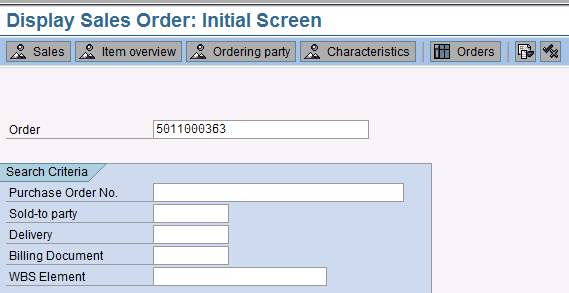
Figure 1
Enter a sales order number in the Display Sales Order screen
This action opens the Display Standard Order Overview screen (Figure 2). In this screen, click the Display doc. Header details icon.

Figure 2
The Display Standard Order Overview screen
In the next screen, click the Conditions tab to view the profit margin for the entire sales order (Figure 3). If you want to restrict who can see certain condition types (i.e., price, discounts, etc.) and subtotal lines (e.g., profit margin), you can put in authorization restrictions. See SAP Note 105621 – Authorization check for the condition screen.
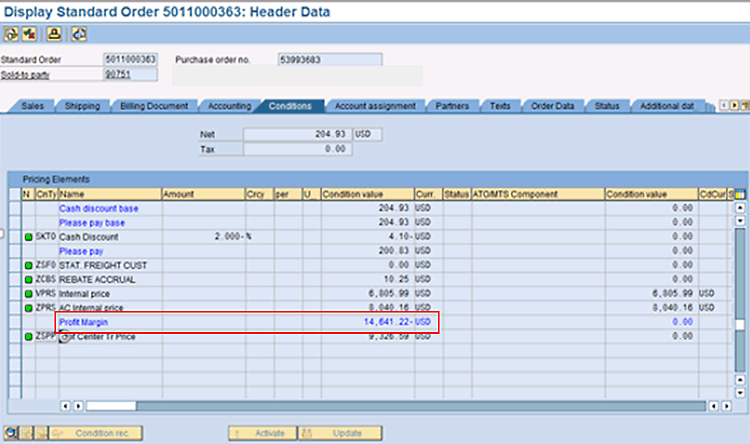
Figure 3
Sales order header conditions
Double-click the Profit Margin line to see condition details, as shown in Figure 4.
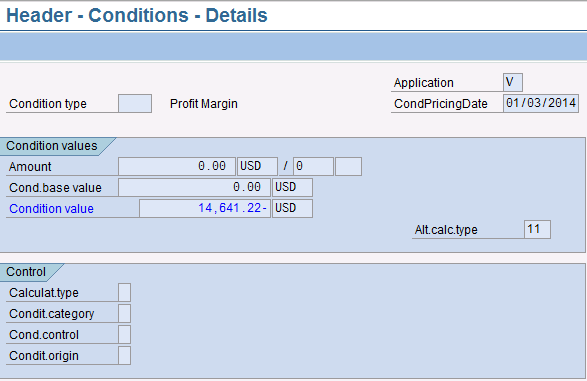
Figure 4
Sales order header condition details
Click inside the Alt.calc.type field to get the drop-down selection icon to appear. Then click the Alt.calctype drop-down icon to see available VOFM formula value routines, as shown in Figure 5. VOFM is an enhancement toolbox that allows you to create or assign routines and calculations to business processes. In this example, the sales order condition type uses routine 11 to compute the profit margin, in dollars, by subtracting cost from the net value.
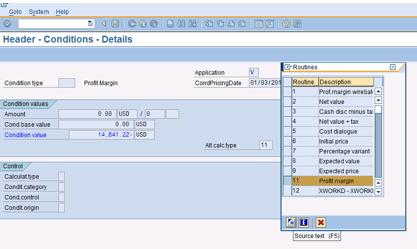
Figure 5
VOFM formula value routines
From the drop-down list, select routine 11 and press F5, as shown in Figure 5. The code, which is shown in Figure 6, calculates the condition value (i.e., profit margin in dollars), stored in KOMV-XKWERT, as the net value of the sales order (i.e., KOMP-NETWR) minus cost (i.e., KOMP-WAVWR).

Figure 6
ABAP code VOFM formula value 11
The profit margin for a specific sales order line item can also be displayed, and therefore, the profit margin for a specific material (i.e., product or finished good) can be displayed. From the SAP application menu, select Logistics > Sales and Distribution > Sales > Order > Display or execute transaction code VA03. In the Display Sales Order initial screen, enter your sales order number in the Order field and press Enter (Figure 7).
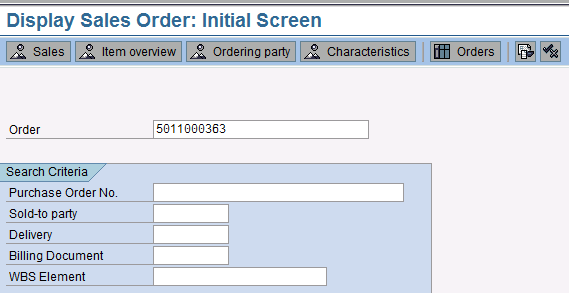
Figure 7
Display sales order
In the display sales order overview screen, double-click a line item (Figure 8).

Figure 8
Select sales order line item
In the next screen, click the Conditions tab to view the profit margin in dollars for the line item (Figure 9).

Figure 9
Display sales order line-item data conditions
At the line-item level, you can display condition type data, as shown previously with the sales order header data. Double-click the profit margin line to see condition details (Figure 10).

Figure 10
Sales order condition details
Figure 10 shows that the profit margin subtotal is assigned to VOFM condition value 11.
To include profit margin as a percentage instead of dollars, you use VOFM routine 18 as the basis for a customer-created routine, which you then assign to the pricing procedure. To see the standard ABAP code for routine 18, follow IMG menu Sales and Distribution > System Modifications > Routines > Define FORM Routines for Data Transfers or use transaction code VOFM. From the Requirements & Formulas screen, select from the pull-down menu Formulas > Condition value (Figure 11).

Figure 11
VOFM formula menu
In the next screen, double-click routine number 18 (Figure 12).
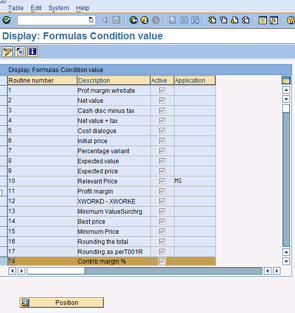
Figure 12
Display VOFM formula condition values
The standard ABAP code for routine 18 is shown below in Figure 13.
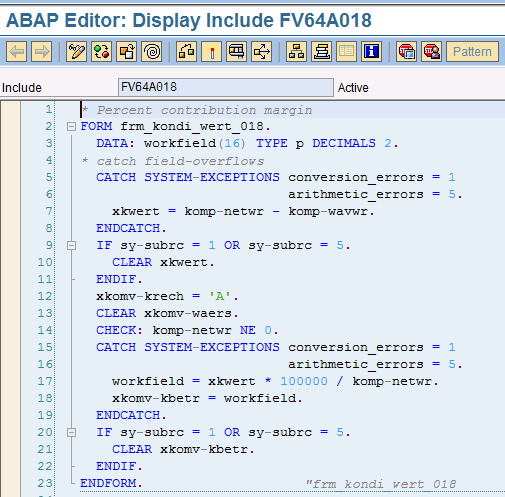
Figure 13
ABAP code VOFM formula value routine 18
As you can see in Figure 13, there is a lot more ABAP code for routine 18 than there is for routine 11. Much of this has to do with potential number conversion and arithmetic errors. The ratio calculation itself is in line 17, and it contains an error in logic. Line 17 multiplies the profit in dollars (i.e., xkwert) by 100000 and then divides by net value (i.e., komp-netwr). Using the SkateRight example from the “Terminology” sidebar, this formula would calculate the profit margin of one skateboard as follows:
The correct calculation is $40 x 100/$50=80%.
To fix the issue, copy routine 18 to create your own customer routine and change the multiplier from 100000 to 100. You now have a custom routine (i.e., customer routine) that you can assign to your pricing condition as a subtotal line.
Populate Subtotals in VBAP and VBRP
To make more permanent use of the product profit margin subtotals for use in reports and queries, you can configure your pricing procedure to populate standard subtotal fields KZWI1-6 in tables VBAP and VBRP. You need to be careful during this process, because there are standard formula values set to populate these fields. So carefully analyze which fields are being populated today and from what routines. Moreover, make sure to carefully document the use of these fields so that a good trail exists in considering future redesign efforts and enhancements.
To populate any of the KZWI1-6 fields, access pricing procedures from IMG menu Sales and Distribution > Basic Functions > Pricing > Pricing Control > Define And Assign Pricing Procedures, or execute transaction code V/08. Select your pricing procedure in the Procedures pane and double-click the Control folder in the dialog structure area in the upper left corner of the screen (Figure 14).
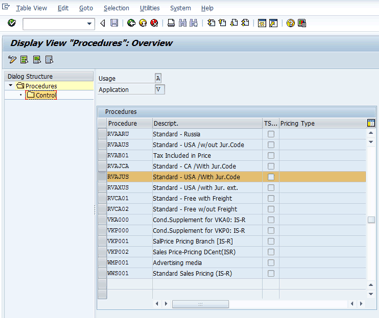
Figure 14
Pricing procedure configuration
This action opens the Control Overview screen (Figure 15). In the Reference Step Overview pane, there is a field under the Su Tot (subtotal) column with the number 6 assigned to it. This indicates that for pricing procedure RVAJUS, the subtotal field KZWI6 will be populated with the profit margin data. The field below the CalTy… (calculation type) column, to the far right side of the screen, contains value 18. This value indicates that the subtotal line will be populated via the VOFM formula value 18.

Figure 15
Pricing procedure Control Overview screen
CO-PA and Product Costing (CO-PC)
Returns and Refunds
Traditionally, there have been a few different approaches in sending return values to CO-PA. One approach, although not a very good one, is to map returns to the same line as sales revenue. The problem with this is twofold. First, CO-PA by default populates all numbers as positive (i.e. no +/- sign). Second, you need to call out your returns separately for analysis.
A better approach for returns, refunds, discounts, and other miscellaneous financial activity is to create a separate value field and map the appropriate condition types to it. Figure 16 is an example in which a value field (e.g., VV010) is mapped to an SD condition type (e.g., ZCTR) for refunds. This configuration is accessed using transaction code KE4I or following IMG menu path Controlling > Profitability Analysis > Flow of Actual Values > Transfer of Incoming Sales Orders > Assign Value Fields.
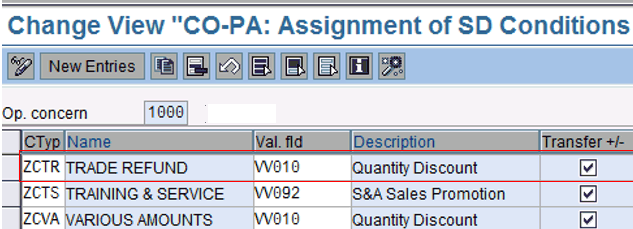
Figure 16
Assign value fields to SD conditions
Once you have your returns, refunds, and other values mapped separately in CO-PA value fields, you need to make sure your CO-PA reports are set up to calculate net profit, using formulas. You can define CO-PA report forms by following IMG menu path Controlling > Profitability Analysis > Information System > Report Components > Define Forms for Profitability Reports.
Figure 17 shows is an example report with the formula line for total gross sales.

Figure 17
CO-PA form formula line total gross sales
In Figure 18 is the same report with the formula line for total gross sales.

Figure 18
CO-PA form formula line total net sales
Notice in Figure 19 that the formula line adds total gross sales (Y008) and sales deductions (Y015) to calculate total net sales. If all the values flowing into CO-PA were positive, this formula would be incorrect. However, in Figure 18 the value fields have the Transfer +/- indicator checked. As such, the values for refunds and returns flow into CO-PA as negative numbers (Figure 19).

Figure 19
CO-PA report with negative values
Warehousing and Analytics
David Burns
David Burns is owner and managing partner of Prime, LLC. David has specialized in SAP Financials since 1998. Since founding Prime, LLC in 2008, he focuses on techno-functional consulting on a cross-modular basis, with a special emphasis on SAP configuration optimization and FI integration.
You may contact the author at david.burns@primepsm.com.
If you have comments about this article or publication, or would like to submit an article idea, please contact the editor.
























